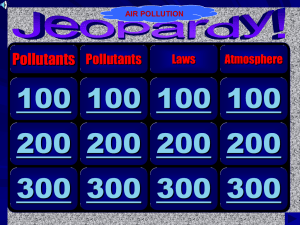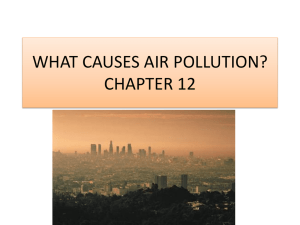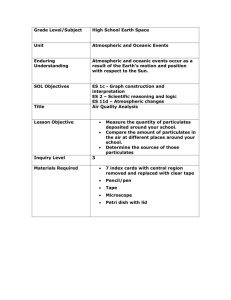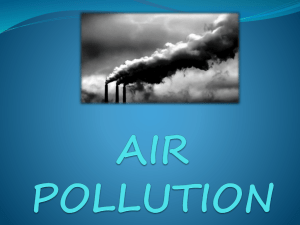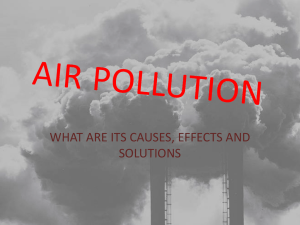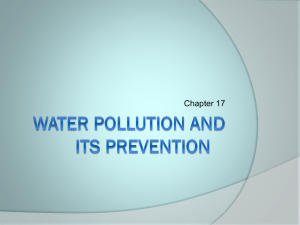AIR POLLUTION - WordPress.com
advertisement
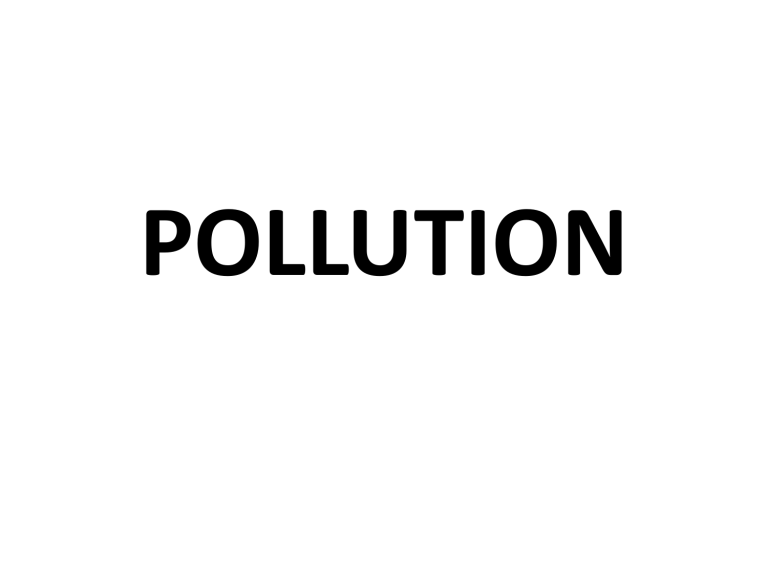
POLLUTION INTRODUCTION Pollution can be defined as the introduction by humans, deliberately or inadvertently, of substances or energy (heat, radiation, noise) into the environment—resulting in a deleterious effect. Whereas, contamination is the presence of elevated concentrations of substances in the environment, food, etc., which may not necessarily be harmful or a nuisance. Pollution can be ‘primary’, having effect immediately on release to the environment ; or ‘secondary’, the product of interaction after release with moisture, other pollutants, sunlight, etc. Pollution may be local, regional, transboundary, or global. The effects may be direct, indirect or cumulative, felt intermittently or constantly, immediate or after a delay ; affecting the atmosphere, water bodies, oceans, ground water, soil or be restricted to certain organisms, produce or localities. The effects of pollution may be short term or longer term ; pose a hazard or a nuisance; be toxic or nontoxic ; take the form of a chemical, biological, radiation,heat, light, noise, dust, or odour problem. AIR POLLUTION • Air pollution is basically the presence of foreign substances in air in excessive concentration which adversely affects the well being of the individual or causes damage to property. • According to World Health Organisation, air pollution is defined as, “substances put into air by the activity of mankind into concentration sufficient to cause harmful effect to his health, vegetables, property or to interfere with the enjoyment of his property.” • Indian Standards Institute define air pollution as, “Air pollution is the presence in ambient atmosphere of substances, generally resulting from the activity of man, in sufficient concentration, present for a sufficient time and under circumstances which interfere significantly with the comfort, health or welfare of persons or with the full use or enjoyment of property.” Historical Overview • • • • (i) London Smog.-1952, (ii) Meuse Valley, Belgium. Dec. 1, 1930 (iii) Donora, Pennsylvania (USA). October 1948 (iv) Pittsburgh. Prior to 1948 the nickname of Pittsburgh was “Smokey City”, and it seemed to be appropriate as a black pall of smoke and soot often turned day into night, and blackened the brightest buildings in a few months. (v) Los Angeles, California. In early 1950’s due to large volume of traffic on Los Angeles streets, photochemical smog is formed by the interaction of HCs and oxidants (like NOx, CO, O3) in the presence of sunlight to form toxic PAN and ozone, causing eye irritation, visibility reduction and damage to crops and rubber cracking. (vi) Bhopal Gas Tragedy December, 1984 Sources of Air Pollutants Classification of Air Pollutants 1. According to Origin • Primary air pollutants are those which are emitted directly to the atmosphere and found there in the form in which they are emitted. For example, particulates, carbon monoxide (CO), oxides of sulphur (SOx),oxides of nitrogen (NOx), hydrocarbons (HCs), radioactive compounds, particles of metal, pollen, bacteria, etc. The five main primary air pollutants (viz. particulates, CO, SOx, NOx and HCs) contribute more than 90% of global air pollution. •Secondary air pollutants are those which are produced in the air by the interaction among two or more primary air pollutants, or by reaction with normal atmospheric constituents, with or without photoactivation. For example, ozone (O3), peroxyacetyl nitrate (PAN), formaldehyde, formation of acid mists, smog (coal induced and photochemical smog),etc. 2. According to Chemical Composition On the basis of chemical composition, air pollutants can be divided as—organic and inorganic air pollutants. • Organic compounds contain carbon and hydrogen, and many also contain certain elements such as oxygen, nitrogen, sulphur and phosphorus. Examples of organic air pollutants are hydrocarbons, aldehydes, ketones, carboxylic acids, organic sulphur compounds, etc. • Inorganic air pollutants include compounds, such as CO, CO2 , SOx, NOx, O3, etc. 3.According to State of Matter On this basis, air pollutants are classified as— particulate and gaseous air pollutants. • Particulate air pollutants include finely divided solids and liquids dispersed in gaseous media. Dust, smoke, fly ash, flumes, etc., are examples of solid particulates ; while mist, spray, fog, etc., are liquid particulate air pollutants. • Gaseous air pollutants are organic gases like benzene, methane, butane, aldehydes, ketones, etc., as well as inorganic gases like CO2, SOx, CO, NH3, H2S, NOx, etc. Effects of Air Pollution on Human Health •The air we breathe has not only life sustaining properties, but also life damaging properties. An average man breathes 22,000 times a day and takes in 16 kg of air each day. The impurities in the inhaled air can affect human health in a number of ways, depending upon the nature and concentration of the pollutants, duration of exposure, and age group of the receptor. The various health effects are : (i) Eye irritation can be caused by many air pollutants such as Nox,O3, PAN, smog, particulates, etc. (ii) Nose and throat irritation can be caused by SO2, NOx, insecticides,pesticides, etc. (iii) Gaseous pollutants like H2S, SO2, NO2 and hydrocarbons can cause odour nuisance even at low concentrations. (iv) Irritation of the respiratory tract can be caused by SOx, NOx, O3,CO, etc. (v) Increase in mortality and morbidity rate. (vi) A variety of particulates, particularly pollens, can initiate asthmatic attacks. (vii) High concentrations of SO2, NO2, SPM (suspended particulate matter) and photochemical smog can aggravate chronic pulmonary diseases like bronchitis and asthma. (viii) Carbon monoxide, which is two hundred times more reactive than oxygen, combines with haemoglobin in the blood and consequently increases stress on those suffering from cardiovascular and pulmonary diseases. Similarly, nitric oxide (NO) can react with haemoglobin and reduce the oxygen carrying capacity of the blood. (ix) Hydrogen fluoride can cause fluorosis and mottling of teeth. (x) Air pollutants such as polycyclic organic compounds, aliphatic hydrocarbons, etc. can cause cancer. (xi) Dust particles can cause dust specific respiratory diseases, such as, silicosis (associated with silica dust), asbestosis (associated with asbestos dust), etc. (xii) Heavy metals, like lead (emitted from vehicles), may enter the body through the lungs and can cause poisoning. Its high concentration can damage liver and kidney, and can cause abnormality in fertility and pregnancy, and mental development of children gets affected. (xiii) Exposure to radioactive isotopes like Iodine 131, Phosphorus 32, Cobalt 60, Radium 226, etc. can cause anaemia (iron deficiency), leukaemia (RBC deficiency), cancer, and genetic defects. Effects of Air Pollution on Animals The process by which the animals get poisoned is entirely different from that by which human beings exposed to air pollutants are poisoned. In case of animals, it is a two-step process : (i) accumulation of air pollutants in the vegetation and forage; and (ii) subsequent poisoning of the animals, when they eat the contaminated vegetation/forage. The pollutants mainly responsible for most livestock damage are : Fluorine : Of all the farm animals, cattle and sheep are the most susceptible to fluorine toxicity. Horses are quite resistant, while poultry are probably the most resistant to fluorine of all the farm animals. Fluorine is a cumulative poison under conditions of continuous exposure to subacute doses. Its effects are lack of appetite, rapid loss of weight,lameness, periodic diarrhoea, muscular weakness, wearing of teeth, and death. Lead : Chronic lead poisoning has been observed frequently in animals that have been grazing near smelters and lead mines. It causes paralysis and difficulty in breathing. In case of acute lead poisoning, the onset is sudden and the course is relatively short. There is complete loss of appetite, paralysis, and diarrhoea. Arsenic : In acute cases, it can cause severe salivation, thirst,vomiting, irregular pulse and respiration, abnormal body temperature, and death in few hours. Chronic arsenic poisoning causes cough,diarrhoea, anaemia, abortion, paralysis, and death. Economic Effects of Air Pollution Air pollution damage to property/material is a very important economic aspect of pollution, and it covers a wide range : (i) Corrosion : Air pollution damages materials chiefly by corrosion of metals. The prime air pollutant responsible for metallic corrosion is SO2. In the presence of oxygen and moisture, it is converted to sulphuric acid. Deposition of this acid on metal parts of building roofs, railway tracks, overhead wires, metal on bridges, and other structures cause enormous loss due to corrosion. (ii) Damage to building materials : The acid deposition reacts with lime stone, marble, and other building materials to cause deterioration and disfigured the building materials. (iii) Damage to paints and protective covering : Pollutants like SO2, O3, H2S, and aerosols damage protective coating and paints of the surface. (iv) Damage of textile dyes and textile fibres : The fading of textile dyes and deterioration of natural and synthetic textile fibres is caused by SOx, NOx, and O3. (v) Rubber Cracking : Rubber cracking of tyres and various forms of electrical insulation is caused by ozone and PAN. (vi) Deterioration of leather and paper : Sulphur dioxide causes leather to lose much of its strength and ultimately disintegrate; which has posed a serious problem of storage of leather bound books in libraries. The impurities in paper absorb SO2 and convert it into H2SO4 in the presence of moisture, which makes the paper extremely brittle and decreases its folding resistance. (vii) Effect on glasses and ceramics : Although glasses and ceramics are especially resistant to the chemical action of air pollutants, but long exposure for years showed a change in their surface appearance. Air Pollutants 1. Particulates Aerosols or particulates are dispersed solid or liquid particles of microscopic size in gaseous media. The term aerosol is applicable as long as the particle is suspended in air. Once the particle settled on a liquid or solid surface, the term no longer applies. However, particulate matter is a nuisance both as an aerosol and as settled or deposited matter. Particulates can either be natural or anthropogenic. Natural particulates include pollen, viruses, bacteria, fungi, spores, protozoa, plant fibres, volcanic dust, etc. while anthropogenic particulates include smoke, fly ash, root particles, acid droplets, inorganic dusts, metallic oxides and salts, metallic fumes, etc. It is the physical characteristics of the particulates which are quite significant in air pollution. The physical characteristics include size, settling properties, mode of formation and optical qualities. Size is one of the most important physical properties of particulates. The surface area of the particulates presents good sites for adsorption/absorption of various organic and inorganic matter. The sizes of the particles, which are of major interest in air pollution, range from 0.01 to 100 μm in diameter. Particulates can generally be classified as suspended or settleable. Suspended particulates vary in size from less than 1.0 μm to approximately 20 μm. They can remain suspended in the atmosphere for long periods of time. The settleable particulates (or dustfall) are larger and heavier particulates. They are generally greater than 10 μm in size and settle out close to their sources. However, the settling rate of particualtes depends upon the size and density of the particulates as well as turbulence of air. • According to their mode of formation, the aerosols are classified as — dust, smoke, fly ash, fumes, mist and spray ; • Dust is made up of solid particles larger than those found in the colloids, and are capable of temporary suspension in air or other gases. • Dust is produced by the crushing, grinding or blasting of organic and inorganic materials such as coal, stones, cement, wood, etc. It may range in sizes from 1 to 1,000 μm. • Smoke is made up of fine solid particles resulting from the incomplete cumbustion of organic particles such as coal, wood, etc. The dia. of smoke particles vary from 0.5 to 1.0 μm. • Fly ash consists of finely divided, non-combustible particles contained in flue gases arising from combustion of coal. Like dust, it has particles that range in size from 12 to 1,000 μm. Like smoke, it results from burning of coal; and like fumes, it consists of inorganic metallic or mineral substances. Fumes are fine solid particles formed by the condensation of solid materials, such as molten metals. For example, metallic oxides of zinc, lead, etc. The particles sizes range from 0.03 to 0.3 μm. Mist consists of liquid particles or droplets formed by the condensation of a vapour, or by the dispersion of a liquid (as happens in foaming or spraying), or by a chemical reaction (such as the formation of sulphuric acid mists). Mists are usually less than 10 μm in dia. If the mist concentration is high enough to reduce visibility, then it is called a fog. Spray consists of liquid particles formed by the atomization of parent liquids such as pesticides and herbicides. Its size ranges from 10 to 1,000 μm. • Effects • Particulate’s effects on human health are immense. The fine particles (< 3 μm in size) are the worst as they can penetrate deep into the lungs through the respiratory tract. Once they are lodged into the lungs, they can cause severe breathing trouble by physical blockage and irritation of the lung capillaries. 2. Carbon Dioxide (CO2) It is a colourless, tasteless, odourless and noncombustible gas that provides the carbonation in soft drinks and beverages. It has been part of the earth’s atmosphere as long as the earth has had an atmosphere. At present the carbon dioxide concentration in the atmosphere is approximately 350 ppm. 3. Carbon Monoxide (CO) It is a colourless, tasteless and odourless gas. It is slightly lighter than air (0.965 times as heavy as air) and is insoluble in water. It is chemically inert under normal conditions and has an estimated atmospheric life of about two and a half months. It is a poisonous gas and is generally classified as an asphyxiant. The atmospheric background of CO is 0.1 ppm. It is produced by (i) incomplete burning of the carbon in fossil fuels 2C + O2 ⎯→ 2CO (ii) reaction between carbon dioxide and carbon containing materials at very high temperatures in industrial processes, such as in electric and blast furnaces CO2 + C ⎯→ 2CO (iii) and by dissociation of carbon dioxide at higher temperatures CO2 CO + O Effects 4. Hydrogen Sulphide (H2S) Hydrogen sulphide is well known for its rotten egg smell. It is produced by the reduction of sulphur. It is a very strong smelling substance and is gaseous at room temperature having a boiling point at – 60°C. It is slightly soluble in water at atmospheric conditions, but groundwater may contain considerably higher concentrations under pressure commonly found in deep aquifers. It imparts an unpleasant taste and odour to water even in small concentrations. It is not toxic in low concentrations that normally exist in the atmosphere (0.0002 ppm), but is toxic in high concentrations. The threshold limit value (TLV) of hydrogen sulphide is 10 ppm. • Effects Exposure to hydrogen sulphide for short periods can result in fatigue. But high concentrations of H2S due to accidental release, often cause fatalities. This occurs in the production and processing of sour gas and oil, which contain hydrogen sulphide. There are many incidences of leakages of H2S from natural gas processing plants killing hundreds of people. 5. Oxides of Sulphur (SOx ) The oxides of sulphur (SOx) are probably the most widespread and most intensely studied of all the anthropogenic air pollutants. They include six different gaseous compounds, viz., sulphur monoxide (SO), sulphur dioxide (SO2), sulphur trioxide (SO3), sulphur tetroxide (SO4), sulphur sesquioxide (S2O3) and sulphur heptoxide (S2O7). In air pollution, SO2 in particular and SO3 are the two most important oxides of sulphur. Effects 6. Ozone (O3) Ozone is a bluish gas with a pungent odour. It can be created by passing a high voltage through dry atmospheric air between two stationary electrodes. It is unstable and breaks down to normal oxygen and nascent oxygen (which is a powerful oxidizing agent). Natural ozone mainly occurs in the stratosphere (between 16 to 40 km), where it serves a vital biological role in absorbing high energy photons of ultraviolet radiation from sun and thus, protects the plants, animals and human beings from the hazardous effects of UV-B radiations*. Natural ozone is also present in troposphere, where it has a background concentration of about 0.02 ppm. Ozone is a life saviour, if present in stratosphere; but a pollutant, if present in troposphere. Effects Ozone is a smelly and poisonous (at higher concentrations) gas.Ozone, which is a major component of photochemical smog along with PAN, has an irritant action in the respiratory track reaching much deeper into lungs than oxides of sulphur. It can cause coughing, shortness of breadth, air-way constriction, headache, chest tightness, altered red blood cells and eye, nose and throat irritation. 7. Oxides of Nitrogen (NOx) Of the seven oxides of nitrogen, viz., nitrous oxide (N2O), nitric oxide (NO), nitrogen dioxide (NO2), nitrogen trioxide (NO3), nitrogen sesquioxide (N2O3), nitrogen tetraoxide (N2O4) and nitrogen pentaoxide (N2O5), that exist in ambient air, only two oxides of nitrogen (NO and NO2) are primarily involved in air pollution. Effects 8. Hydrocarbons (HCs) Hydrocarbons are those organic compounds which contain only carbon and hydrogen. Like CO, they represent unburned and wasted fuel. Most of the major chemicals in gasoline and other petroleum products are hydrocarbons, which are divided into two categories— aliphatic and aromatic. Aliphatic hydrocarbon group contains alkanes, alkenes and alkynes. The alkanes are saturated hydrocarbons (i.e., methane) and are fairly inert,and generally not active in atmospheric photochemical reactions. The alkenes, generally called olefins, are unsaturated and highly reactive in atmosphere. The alkenes (such as ethylene), in the presence of sunlight,react with nitrogen dioxide at high concentrations to form secondary pollutants such as PAN (peroxyacetyl nitrate) and ozone. The alkynes,though highly reactive, are relatively rare and thus not of major concern in air pollution. Aromatic hydrocarbons are biochemically and biologically active, and some are potentially carcinogenic. They are derived from or related to benzene. Though aromatics do not display the reactivity characteristics of unsaturated aliphatic hydrocarbons, but the polynuclear group of aromatic hydrocarbons are carcinogenic. • Effects • Hydrocarbons are generally not toxic at concentrations normally found in the atmosphere, but they are major pollutants because of their role in the formation of photochemical smog. • Experimental tests on humans and animals with aliphatichydrocarbon concentrations of 500 ppm produce no harmful effects. But polynuclear group of aromatic hydrocarbons from automative exhaust emissions are carcinogenic in nature. • Ethylene, produced in automobile exhaust, is one of the very few hydrocarbons that can cause plant damage even at low concentrations. Tomato and pepper plants, and orchids can be severely damaged if they are exposed to ethylene (0.01 to 0.3 ppm) for longer duration. Air Pollution Control Atmospheric Self-Cleansing Processes The atmosphere, like a stream or river, has natural built-in selfcleansing processes. Dispersion, gravitational settling, flocculation, absorption, rain out, and adsorption are some of the most significant natural removal mechanisms at work in the atmosphere. Though not literally a removal mechanism, dispersion of pollutants by wind decreases the concentrations of pollutants at any place. Gravitational settling is one of the most important natural mechanisms for removing particulates from the atmosphere, especially particles larger than 20 μm in size. It also plays an important role in several of the other natural atmospheric cleansing processes . In flocculation, larger particles act as receptor for smaller ones to form a unit, and the process is repeated until a small floc is formed, which is large and heavy enough to settle under gravity. In the natural absorption process, particulates or gaseous pollutants are collected in rain or mist and then settle-out with moisture. This phenomenon is known as washout or scavenging, it takes place below cloud level. Rainout is another natural cleansing process that occurs within the clouds, when submicron particulates serve as condensation nuclei around which drops of water may form. This phenomenon has resulted in increased rainfall and fog formation in urban areas. Adsorption occurs primarily in the friction layer of the atmosphere, i.e., the layer close to the earth’s surface, such as soil, rocks, leaves or blades of grass, where they are concentrated and retained. Approaches to Air Pollution Control (i) Dispersion of source locations. Air pollution can be controlled/ checked by dispersion of the sources of air pollutants, through allocation of land, i.e., by proper planning and zoning of industrial areas. (ii) Dilution. By using tall stacks for industries or thermal plants, the emissions or pollutants can be discharged at a sufficient height from the ground, where the air movement, both horizontal and vertical, is more and chances of downward movement of air (i.e., inversion conditions) are less. This will help in dispersion of pollutants over a larger area in less time, and hence dilute the concentrations of pollutants near the source. (iii) Reduction at source by process changes. This can be achieved by: (a) substitution of raw materials; e.g., the use of low-volatile coal in place of high-volatile coal, eliminates smoke and soot. (b) substitution of fuel ; e.g., desulphurization and de-ashing reduce emissions of SO2, SPM (suspended particulate matter) and ash. Similarly, natural gas can be used in place of coal, to minimise emissions. (c) modification of the process; e.g., in case of disposal of combustible refuse, sanitary landfill can be used instead of incinerators. (d) modification of the process equipment, or repair and maintenance of existing equipment helps in reducing atmospheric pollution. (iv) Reduction at source by using control equipment. This is the most effective method for reducing air pollution at source. Various control devices are used for controlling different types of pollutants emitted from different sources. (A) CONTROL DEVICES FOR PARTICULATE CONTAMINANTS (1) Settling Chamber. (2) Cyclone (3)Filter (4) Electrostatic Precipitators (ESPs). (5) Scrubbers or Wet Collectors. Spray Tower (B) CONTROL DEVICES FOR GASEOUS CONTAMINANTS multiple fixed bed adsorber Plate or tray towers Packed towers


